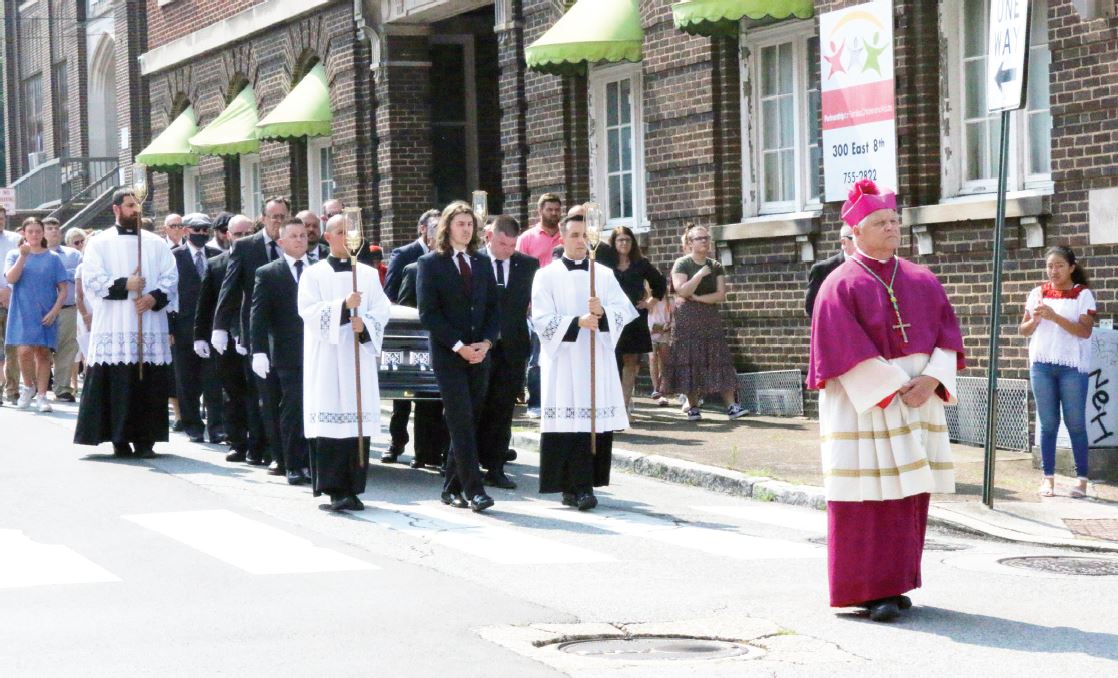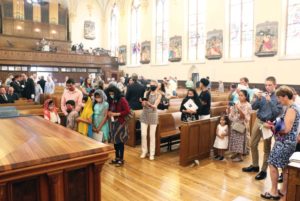Remains of historic Chattanooga priest moved to specially built tomb inside the basilica
By Dan McWilliams
As Bishop Richard F. Stika presided at the memorial Mass and re-entombment of Servant of God Father Patrick Ryan on July 31 at the Basilica of Sts. Peter and Paul, a miracle attributable to the Chattanooga hero was possibly already in the works.
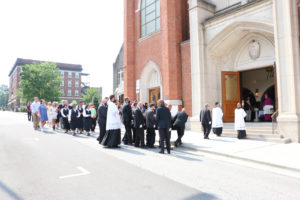
Pallbearers carrying the remains of Father Patrick Ryan enter the Basilica of Sts. Peter and Paul in Chattanooga on July 31.
Father Ryan was pastor of the downtown parish when he ministered to yellow-fever victims in Chattanooga, then died of the disease himself in 1878, just a day short of his 34th birthday.
“A life well lived, a short one. There’s no greater gift than to give your life for your friends,” the bishop said in his opening remarks.
Cardinal Justin Rigali attended the memorial Mass in choir. Concelebrants were basilica rector Father David Carter, who is the episcopal delegate for the cause of Father Ryan’s sainthood; Father John Orr, pastor of St. Mary Parish in Athens and the promoter of justice in the cause; Father Valentin Iurochkin, parochial vicar at the basilica; Father Nick Tran, who lives at the basilica and is pastor of the Vietnamese St. Faustina Public Association of the Faithful; and Father Marcin Gladysz, associate pastor at the Cathedral of the Most Sacred Heart of Jesus.
Deacon Gaspar DeGaetano of the basilica, the diocesan postulator in the sainthood cause, was deacon of the Gospel. The basilica’s Deacon Tom O’Connell proclaimed the readings, and the downtown parish’s Deacon Hicks Armor, notary for the sainthood cause, was master of ceremonies.
Also present were diocesan chancellor Deacon Sean Smith, Fourth Degree Knights of Columbus from East and Middle Tennessee, pallbearers, altar servers who included Diocese of Knoxville seminarians, and musicians who included the Gloria Dei Schola from the basilica and, playing outside before Mass, bagpiper Katie Helms. Knights state deputy Fred Laufenberg attended, as did Religious Sisters of Mercy of Alma, Mich., and Missionary Sisters of the Sacred Heart of Jesus “Ad Gentes.”
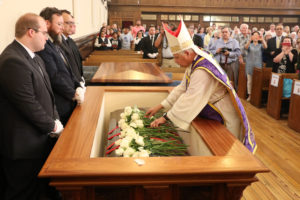
Bishop Stika places 51 roses on the casket of Father Ryan representing the 51 Diocese of Knoxville parishes and one Catholic mission as pallbearers watch.
The Mass followed a morning procession from Mount Olivet Cemetery in Chattanooga, where Father Ryan’s remains were exhumed and identified earlier in the week and placed in a new coffin. The procession echoed one in 1886, when Father Ryan was reburied from a cemetery near Sts. Peter and Paul into the then-new Mount Olivet across town. Crowds of all faiths lined the streets of River City for miles 135 years ago as the cortege traveled to the cemetery, where the young priest became the first person buried there.
When Father Ryan’s coffin, containing a full skeleton overlaid with new vestments, arrived July 31 at the basilica, the bishop and Father Carter led another procession of Knights, servers, and parishioners behind the pallbearers two blocks down 8th Street into the church.
Bishop Stika delivered his homily to a nearly full basilica.
“‘Into your hands, O Father, I commit my spirit,’” he said. “I wonder if so many decades ago perhaps those were the last words of Father Patrick Ryan, a priest of the Diocese of Nashville at the time and a son of Ireland. It was very similar to what St. John Paul said: ‘Let me return to the house of my Father.’ I’m sure so many decades ago Father Ryan would not have understood what we are doing today. A simple son of Ireland—to have all of us present, all of this commotion, in the midst of an epidemic just as dangerous as was the epidemic of yellow fever.”
When Father Ryan’s body was moved in 1886, “the city stopped,” Bishop Stika said. “A city that for sure had so small of a Catholic population—the city stopped as the procession traveled over the streets to Mount Olivet Cemetery. And now, according to Deacon Gaspar, it traveled pretty much the same route back.”
Father Ryan “did indeed give his life for his friends—friends who were not Catholic, friends who were Catholic, even friends who he did not know,” the bishop said.
The memory of the young priest of the 19th century is still celebrated, Bishop Stika said.
“There are people who are alive today because their ancestors may not have died from yellow fever—perhaps this priest of God gave them comfort, the Irish smile of kindness, a twinkle. Maybe he blessed them,” he said.
“We do know that the son of Ireland, the son of Nashville, and now the son of Knoxville is somebody we can hold dear to our own hearts because the very blessings of his life are what we should all emulate. That we should never see another as a stranger, that we should never ignore the other person because maybe it might inconvenience us, and maybe in this pandemic that we do not know when the end will come, maybe Father Ryan might say to us in his old Irish brogue, ‘Shush. Care for your neighbor.’ And if they had a vaccine for yellow fever, I have no doubt that he would have taken it because it would have furthered his life to assist another person,” the bishop added.
In the day’s Gospel reading of the good thief and the bad thief, the latter said to Jesus, “Save yourself and us.”
“Perhaps Father Ryan is reaching into our lives today—some probably said to him, ‘Abandon the city. Save yourself,’” Bishop Stika said.
There is “also a challenge for all of us to follow the example of Father Ryan’s life, to never be uncomfortable when another person reaches out to us as perhaps they reached out to Father so many decades ago for comfort or a smile,” the bishop said.
“In this day and age, when so many people are confused and so many people are alienated and there are so many divisions in the Church and outside the Church, let Father Ryan be an example and a model. And even though it might inconvenience us, he invites us, like Jesus did for the Apostles, to come and to follow, not just to say it but to do it, this martyr of charity.”
In his closing remarks at Mass, the bishop urged the faithful to get a COVID-19 vaccine. He also asked them to pray for Father Ryan’s “intercession for a broken world, a broken Church, and broken individuals.”

Father David Carter, rector of the Basilica of Sts. Peter and Paul, Father Valentin Iurochkin, parochial vicar of the basilica, and Deacon Hicks Armor, who serves at the basilica, are joined by Knights of Columbus as they lay a pall over the casket of Servant of God Father Patrick Ryan, whose remains were entombed inside the basilica on July 31.
Father Ryan’s tomb inside the basilica was detailed by Deacon Otto Preske of Good Shepherd Parish in Newport. The tomb lies in the front-right part of the nave, between the altar rail and the first row of pews in the side aisle. Overlooking the young priest’s tomb is one of the basilica’s Stations of the Cross—the 14th Station: Jesus is laid in the tomb. Pallbearers gently lowered Father Ryan’s coffin into the new burial vault made of oak and mahogany.
“Bless this tomb. Grant that your Servant of God, Father Patrick Ryan, may again sleep here in peace among the people of Chattanooga and of this parish,” Bishop Stika said. “In the sure and certain hope of the resurrection to eternal life through our Lord Jesus Christ, we commend to Almighty God the Servant of God, Father Patrick Ryan, former pastor of the parish and now the Basilica of Sts. Peter and Paul. And we commit his body to this tomb that we made. The Lord bless him and keep him. The Lord make His face to shine upon him and be gracious to him.”
The bishop dropped dirt from Father Ryan’s gravesite at Mount Olivet onto the coffin.
“Father Patrick Ryan—again we are all reminded that we are dust and to dust we shall return,” Bishop Stika said.
The bishop also placed 51 white roses on the coffin, representing the diocese’s 50 parishes and one Catholic mission. The coffin is wrapped with red ribbon that is marked with the bishop’s official seal with his coat of arms. The ribbon will be removed and the coffin opened only when a miracle leads to Father Ryan’s beatification.
“I hope I live long enough to attend the beatification, which would be in Chattanooga—that’s what Pope Francis has told us,” Bishop Stika said, remarks that drew a round of applause.
Father Carter said the memorial Mass was a sign of good news for the Church.
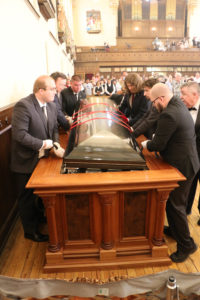
Pallbearers lower the casket with Father Ryan’s remains into the new oak and mahogany tomb with green marble panels from the basilica’s old side altar.
“The Catholic Church has been in the news a lot lately for the sins of her priests. Today, it’s our hope that the Catholic Church is in the news for the bright lights and the ones who truly lived out the priestly ministry that Jesus Christ entrusted to His Church,” the basilica rector said. “Father Patrick Ryan was a true priest whom all priests should seek to emulate, one who offers his life for the sake of the sheep that he shepherds. That is what we are celebrating today, and that for us I think should overshadow all other bad things, not to cover them up but to say there has been bad, but there has been great good also.”
Also placing white roses in the tomb of Father Ryan were women who had prayed for his intercession.
“The diocesan inquiry into the offer of life of Father Patrick Ryan has as its specific scope to learn the history from the historical commission of Father Patrick Ryan and all of the exhaustive research that we have done about his life, his times, and the events around him, but also to interview those who claim favors of intercession from him,” Father Carter said.
“And we have interviewed several people, and some of them were the ones who were placing roses into his tomb today. None of them right now are candidates for an official miracle that would go through the scrutiny that the Church requires to declare him blessed or saintly, but we are of course still open to this possibility and praying that Father Patrick Ryan might show that he has that closeness to God and that he might intercede on behalf of whomever might invoke his name, that he might eventually do that,” Father Carter continued.
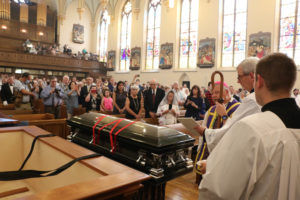
Bishop Richard F. Stika prepares to bless the new tomb for Father Patrick J. Ryan with holy water. By entombing his remains inside the basilica, the Diocese of Knoxville has completed another step in the cause for sainthood for Father Ryan.
“The diocesan inquiry was looking into the actual life and events, especially his offer of life, and seeing if that cause is worthy. Once we compile that, and the authentication of his relics was a side part of that, but once we close that inquiry, we will send that to Rome with all of our opinions on the matter, and we pray that Rome would, with all the information that we send to them, declare him venerable,” he added.
Father Carter said the date for the close of the inquiry is “fluid” but that he hopes it might come at Christmastime.
“It would be a nice year- or year-and-a-half-long process of interviewing, studying, and praying, and honoring his relics,” he said.
The Father Ryan historical commission ran into a humorous snag when it investigated in the priest’s home country.
“When we researched in Tipperary, Ireland, we called up to the parish and said, ‘We’re looking for the baptismal record for Patrick Ryan,’” Father Carter said. “They said, ‘What year?’ We said, ‘1844, 1845, around there.’ They said, ‘What’s his name?’ ‘Patrick Ryan.’ They laughed at us. They said, ‘You’re kidding me.’ In one month of 1844, they had something like 100 Patrick Ryans baptized in the Church.”
Bishop Stika commented on what was a monumental day for the diocese, the day of Father Ryan’s memorial Mass that culminated a week that included the exhumation and identification of relics at the cemetery.
“These last few days have kind of brought tears to my eyes. Why? Because he’s a priest of Knoxville now,” the bishop said. “Priests take a pledge of obedience to their bishop and their successors. I now have this unique relationship with him, because I made the decree about the Servant of God. We’re hoping that maybe next year the pope will—it will be the pope himself who has to declare him venerable, and then we pray through his intercession for some miracles.”
Father Ryan would have gotten a yellow-fever vaccine had one been available, Bishop Stika suggested.
“I was kind of strong in urging people to get the [COVID] vaccine because I think in his day and age if there was as it is now, he probably would have done the same thing, to save lives, especially if it was morally acceptable. In his short life, he touched the lives of so many. All these decades later, we gather together. A man whose powerful presence in his day and age reminds us to care for others and also to pray for those involved in health care. He was ministering to people for health as well as spiritually,” the bishop noted, pointing out that Father Ryan returned “home” on July 31.
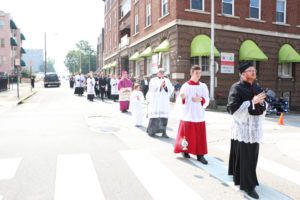
Father David Carter, rector of the Basilica of Sts. Peter and Paul, processes down Chattanooga’s East 8th Street, followed by Deacon Sean Smith, Diocese of Knoxville chancellor, and Bishop Richard F. Stika.
“It’s a different [Sts. Peter and Paul] church, but it’s kind of the same piece of property, so we just pray for his intercession,” he said.
Bishop Stika said the Father Ryan cause is the first sainthood effort he has witnessed “up close and personal.”
“I’ve been privileged in my life to know St. John Paul, to meet him at least, and Mother Teresa,” he said. “I think this is a little different. Up north where the dioceses have been around for a long time, I’m thinking of St. Katharine Drexel in Philadelphia and St. Rose Philippine Duchesne in St. Louis, my hometown. It just shows the vitality and growth of missionary churches like the Diocese of Knoxville. It really is, especially in this basilica recognized by the pope, very special.”
One person who believes very much in miracles—and in Father Ryan’s heavenly efforts on that behalf—was among the women who placed flowers in the priest’s tomb at the end of Mass.
Teresa Shramko explained her connection to the possible saint.
“My son Joseph was in an accident in April over spring break in Boston. He fell out of a second-story window,” she said. “We had said prayers but never had to have an intercession for any reason. When my son had his severe accident, we immediately thought of Father Patrick Ryan. I don’t really know why he came to me. We asked our rosary [group] to pray for Joseph, which my friends do every Wednesday. They do an intercession through Father Patrick Ryan every Wednesday for him. We just kept asking for prayers and prayers.”
The prayers were answered, Mrs. Shramko believes.
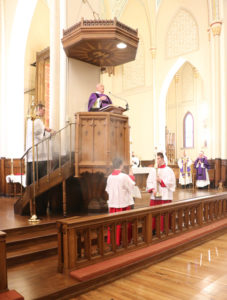
Deacon Gaspar DeGaetano of the basilica, who serves as diocesan postulator for the cause of sainthood for Father Ryan, delivers the Gospel during the memorial Mass for the Servant of God.
“Joseph was in an induced medical coma for a month. He had a lot of swelling but then got better and just continued to get better from there, just waking up and responding,” she said. “Now he’s talking. He’s moving. He’s learning to walk again. We’re continuing to see prayers [answered] every day. The prayers have been just working nonstop.
“Every day it’s something else. Different prayers are always being said—like his left arm wasn’t moving or his left side wasn’t working great. Now he’s able to move the left arm. Now he’s able to use the left leg. He didn’t have a voice, he wasn’t talking—now he’s able to vocalize and use words. He’s able to talk and communicate. Doctors foresee that he’s going to be walking again.”
Mrs. Shramko said it was “hard to say” whether Joseph’s doctors believe that a miracle has occurred.
“I definitely think it’s a miracle,” she said. “When we were in Boston, I do have to say that the doctors were very fascinated by his recovery, how fast he had recovered from going into an induced medical coma to being able to respond. They knew that people were praying for us back in the community. Even one of the nurses, when she came to see Joseph in his hospital room, said, ‘Wow, those prayers are really being answered.’ One of the neurologist residents said, ‘I would be the first one to admit that I never thought this would be what I’m seeing today.’”
The doctors “were probably preparing me for the worst” immediately after the accident, Mrs. Shramko said.
“They weren’t sure. They couldn’t tell me. He wasn’t awake. They couldn’t say whether he was ever going to be awake, whether he was ever going to breathe on his own,” she said.
Joseph is 16 and a rising junior at Notre Dame High School, an institution founded in 1876 under Father Ryan’s leadership at the future basilica.
“Everybody there has been fantastic. Mr. [school president George] Valadie, who has retired, has been fantastic. The community there, the teachers, the school, parents, have been so gracious to us, and we’ve been so grateful for everything they’ve done, the prayers,” Mrs. Shramko said.
She attended the memorial Mass with three friends—Rose Lovelace, Nathalie Strickland, and Jennifer Fillauer— who call themselves “Joseph’s prayer warriors,” part of that Wednesday rosary group that has some 50-plus members.
“They’ve all been really great with the prayers for Joseph, so kind,” Mrs. Shramko said.

